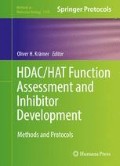Abstract
Aberrant histone deacetylase (HDAC) activity often correlates with neoplastic transformation and inhibition of HDACs by small molecules has emerged as a promising strategy to treat hematological malignancies in particular. Treatment with HDAC inhibitors (HDACis) often prompts tumor cells to undergo apoptosis, thereby causing a caspase-dependent cleavage of target proteins. An unexpectedly large number of proteins are in vivo caspase substrates and defining caspase-mediated substrate specificity is a major challenge. In this chapter we demonstrate that the hematopoietic transcription factor PU.1 becomes cleaved after treatment of acute myeloid leukemia (AML) cells with the HDACis LBH589 (panobinostat) or MS-275 (entinostat). To define caspase specificity for PU.1, an in vitro caspase assay including caspases 1–10 with in vitro-translated PU.1 is described in detail.
Access this chapter
Tax calculation will be finalised at checkout
Purchases are for personal use only
References
Bolden JE, Peart MJ, Johnstone RW (2006) Anticancer activities of histone deacytylase inhibitors. Nat Rev Drug Discov 5(9):769–784
New M, Olzscha H, La Thangue NB (2012) HDAC inhibitor-based therapies: can we interpret the code? Mol Oncol 6(6):637–656
Buchwald M, Krämer OH, Heinzel T (2009) HDACi-targets beyond chromatin. Cancer Lett 280(2):160–167
Falkenberg KJ, Johnstone RW (2014) Histone deacytylases and their inhibitors in cancer, neurological diseases and immune disorders. Nat Rev Drug Discov 13(9):673–691
Witt O, Deubzer HE, Milde T et al (2009) HDAC family: what are the relevant targets? Cancer Lett 277(1):8–21
West AC, Johnstone RW (2014) New and emerging HDAC inhibitors for cancer treatment. J Clin Invest 124(1):30–39
Crawford ED, Wells JA (2011) Caspase substrates and cellular remodeling. Annu Rev Biochem 80:1055–1087
Thornberry NA, Rano TA, Peterson EP et al (1997) A combinatorial approach defines specifities of members of the caspase family and granzyme B. Functional relationships established for key mediators of apoptosis. J Biol Chem 272(29):17907–17911
Poreba M, Strozyk A, Salvesen GS et al (2013) Caspase substrates and inhibitors. Cold Spring Harb Perspect Biol 5:a008680
Hess-Stumpp H, Bracker TU, Henderson D et al (2007) MS-275, a potent orally available inhibitor of histone deacytylases-the development of an anticancer agent. Int J Biochem Cell Biol 39(7-8):1388–1405
DeAngelo DJ, Spencer A, Bhalla KN et al (2013) Phase Ia/II, two-arm, open-label, dose-escalation study of oral panobinostat administered via two dosing schedules in patients with advanced hematologic malignancies. Leukemia 27(8):1628–1636
Klemsz MJ, McKercher SR, Celada A et al (1990) The macrophage and B cell-specific transcription factor PU.1 is related to the ets oncogene. Cell 61(1):113–124
van Riel B, Rosenbauer F (2014) Epigenetic control of hematopoiesis: the PU.1 chromatin connection. Biol Chem 395(11):1265–1274
Rosenbauer F, Wagner K, Kutok JL et al (2004) Acute myeloid leukemia induced by graded reduction of a lineage-specific transcription factor, PU.1. Nat Genet 36(6):624–630
Metcalf D, Dakic A, Mifsud S et al (2006) Inactivation of PU.1 in adult mice leads to the development of myeloid leukemia. Proc Natl Acad Sci U S A 103(5):1486–1491
Zhao M, Duan XF, When DH et al (2009) PU.1, a novel caspase-3 substrate, partially contributes to chemotherapeutic agents-induced apoptosis in leukemic cells. Biochem Biophys Res Commun 382(3):508–513
Herzog N, Hartkamp JD, Verheugd P et al (2013) Caspase-dependent cleavage of the mono-ADP-ribosyltransferase ARTD10 interferes with its pro-apoptotic function. FEBS J 280(5):1330–1343
Treude F, Kappes F, Fahrenkamp D et al (2014) Caspase-8-mediated PAR-4 cleavage is required for TNFa-induced apoptosis. Oncotarget 5(10):2988–2998
Hartkamp J, Carpenter B, Roberts SG (2010) The Wilms’ tumor suppressor protein WT1 is processed by the serine protease HtrA2/Omi. Mol Cell 37(2):159–171
Acknowledgements
This work was supported by the START program of the Medical School of the Rheinische-Westfälische Technische Hochschule (RWTH) Aachen University to J. Hartkamp.
Author information
Authors and Affiliations
Corresponding author
Editor information
Editors and Affiliations
Rights and permissions
Copyright information
© 2017 Springer Science+Business Media New York
About this protocol
Cite this protocol
Treude, F., Gladbach, T., Plaster, J., Hartkamp, J. (2017). Assessment of HDACi-Induced Protein Cleavage by Caspases. In: Krämer, O. (eds) HDAC/HAT Function Assessment and Inhibitor Development. Methods in Molecular Biology, vol 1510. Humana Press, New York, NY. https://doi.org/10.1007/978-1-4939-6527-4_2
Download citation
DOI: https://doi.org/10.1007/978-1-4939-6527-4_2
Published:
Publisher Name: Humana Press, New York, NY
Print ISBN: 978-1-4939-6525-0
Online ISBN: 978-1-4939-6527-4
eBook Packages: Springer Protocols

